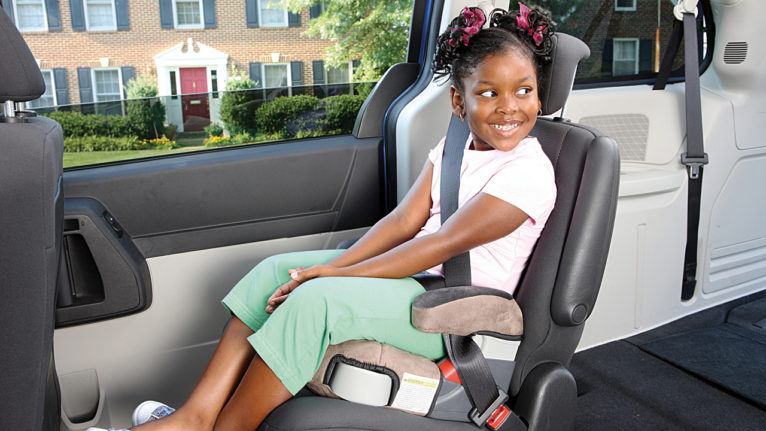Does your kid look like they’re going to burst out of their car seat? Must be time for a booster, right? Not so fast—here are signs they’re ready to make the switch.

Leslie Boyle thought long and hard about whether her oldest son, Carter, then five years old, should make the switch from a forward-facing car seat to a booster seat. “I’ve done a lot of research over the years on car seat safety, and we wanted to make sure that when we did switch him, it was safe to do so,” says the mom of three.
Moving Carter to a booster seat was, in part, an issue of timing. Boyle’s youngest son was outgrowing his infant car seat, so they either needed to get another convertible car seat or move Carter to a booster. “Carter was above the height and weight minimums for a booster, and was able to sit safely while awake and asleep,” she says. “He’s a rule-oriented kid, so once he knew what was expected in his new seat, he was fine.”
Is there a booster seat age requirement? What about height and weight?
Does your kid look like they’re going to burst out of their car seat? Must be time for a booster, right? Not so fast, says Jen Shapka, a certified child passenger safety technician with the Child Passenger Safety Association of Canada and a mom of two in Winnipeg. “Children are ready for a booster seat when they are over 40 pounds and have the physical maturity to remain seated properly at all times, including when asleep,” she explains. Some kids will be ready for the switch to a booster around age five, but most will be closer to six or seven years old.
How do I know if my kid is ready for a booster seat?
Behavioural maturity is critical because kids in booster seats have to be able to sit tall with the vehicle’s seat belt snug against them and touching the strongest parts of their body (the pelvis and shoulder), regardless of distractions. Say they drop a toy or their sister kicks them—how will they react? “If they decide to slither out of their belt, their risk of injury goes way up,” says Shapka. Kids also need to be big enough to stay in position when they fall asleep, she adds, because if they’re flopping forward, they’re more likely to be seriously hurt in an accident.
How to choose a booster seat
There are three general types of booster seats: a car seat that converts to a booster, a high-back dedicated booster and a backless dedicated booster.
If your car seat features a booster seat mode, it may be tempting to go this route, but Shapka points out that there are drawbacks. “This seat doesn’t tend to fit the child for very long, and often not very well, in booster mode,” she explains, adding that these seats are bulkier and sit higher than dedicated boosters, making it harder for a kid to get their belt buckled or unbuckled.
Instead, Shapka recommends a dedicated booster seat with a high back (over a backless model). A high-back seat feels more familiar and secure for a new booster rider, provides some head support for when your kid is sleeping or tired, and usually offers a better shoulder belt fit. Plus, the back is removable on the majority of models, so it can become a backless booster as your child grows.
Finding a booster that’s comfortable for your kid and also suits your vehicle can take some work, and there are a few key things to consider. With some booster seats, reaching both the seat belt and buckle can be tricky, especially if your vehicle has deep, contoured seats or a low, recessed buckle. Additionally, the vehicle’s shoulder belt may not co-operate with the shape of the booster seat or the shoulder belt guide, which can cause slack in the seat belt (a major safety problem). The vehicle’s headrest can also interfere with the fit of the booster seat.
If you can’t try a booster seat in your vehicle with your child before you buy, it’s a good idea to speak with a certified car seat technician and call the brand’s customer service line to ask about vehicle-booster-seat compatibility. Boyle sought advice from various car seat techs. “I also spoke with customer service to inquire about fit in our vehicle as well as the safest configurations,” she says.
You can also check the installation of your booster seat at a car seat clinic in your community. Organizations like the Child Passenger Safety Association of Canada and St. John Ambulance host clinics regularly in cities across the country.
How to transition to a booster seat
Switching to a booster seat is a big change, and some kids are more comfortable with that than others. Shapka recommends a slow transition to the booster, starting with shorter trips around town. Parents should check in with their kid regularly to see how they’re doing. If they’re not comfortable, you may need to go back to the car seat for a while, or maybe even just swap it back in for longer trips.
For Shapka’s daughter, who was five and a half years old when she started riding in a booster seat, the transition took some time. “She really struggled with rides longer than 15 minutes,” she says. “She was so used to the harness doing the work for her that it took a lot of effort to stay sitting up tall at first.”
Other kids, though, take to the booster seat right away. “Carter loved the switch,” says Boyle. “It gave him some independence, and he also got a cup holder, so he was excited about that!”
FILED UNDER: Booster seats car safety Car seats child safety convertible car seat service seo
Source link : https://www.todaysparent.com/kids/school-age/booster-seat-age












